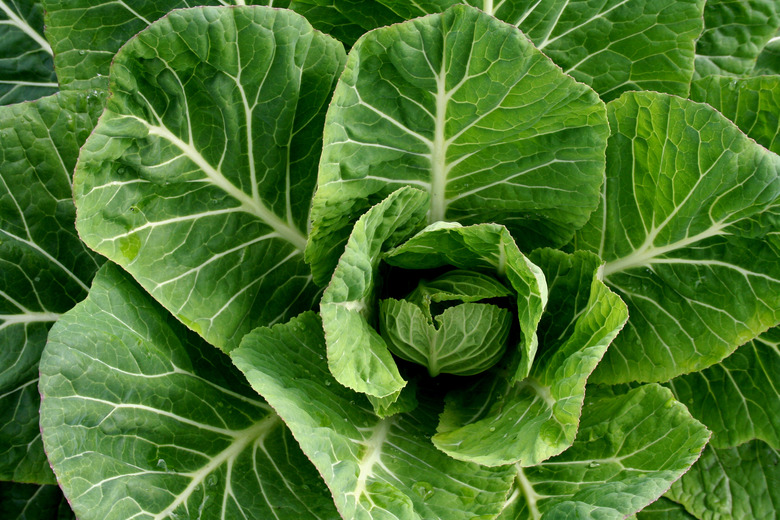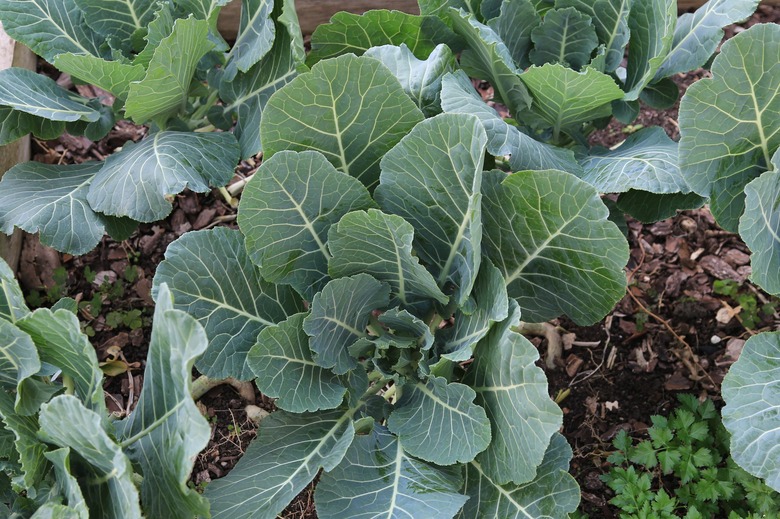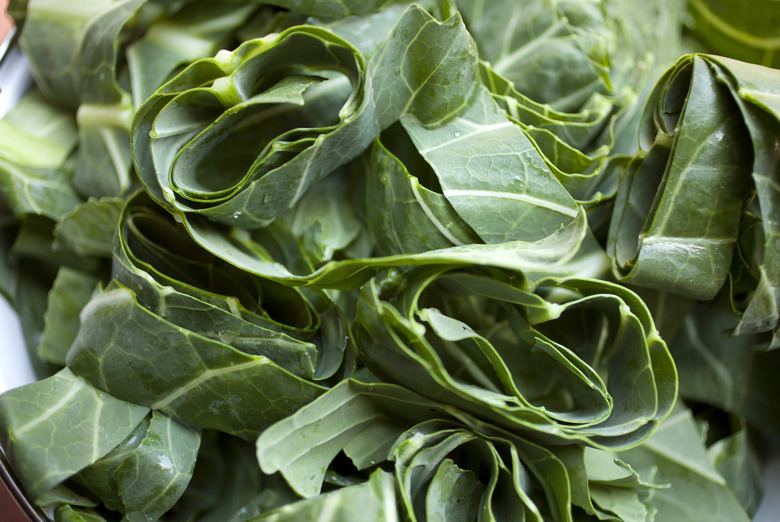How To Grow Collard Greens
We may receive a commission on purchases made from links.
- Best uses for collard greens
- How to grow collard greens
- Starting collard greens from seed
- Starting collard greens from a seedling
- In what zone do collard greens grow best?
- When should you plant collard greens?
- Soil, sunlight and water recommendations for collard greens
- How to winterize collard greens
- How to harvest collard greens
- Common pests and other problems for collard greens
- Common diseases for collard greens
Collard greens (Brassica oleracea [Acephala Group]) are vegetables in the same cole-crop family as cabbage, broccoli and kale, which are all also members of the mustard family (Brassicaceae). These plants are fairly large for a garden area, and they have dark-green leaves that grow together in an attractive rosette shape. Collard greens are very hardy cold-season vegetables that do better in hot weather than other cole crops, and they are a very low-maintenance choice for a home garden area.
Collard greens can be grown in the spring or fall although many believe that fall crops produce a better-tasting vegetable, as a little bit of frost seems to bring out more in the taste. This vegetable resembles certain types of lettuce in appearance, but the plant is dark green in color, and the leaves have a more waxy appearance.
Very high in nutrients and fiber and low in calories, collard greens are an extremely healthy vegetable. Originally from the Mediterranean region, this plant comes in many different cultivars, including Blue Max, Champion, Vates, and Georgia. In the United States, collard greens are well-known for having a long history that is tied to the cuisine of the South, although the plant is grown and eaten all over the country.
Best Uses for Collard Greens
Best Uses for Collard Greens
Collard greens boast nicely arranged leaves, and the plant can be grown as an ornamental as well as a garden vegetable. Because of this, it is possible to plant them in either a front yard or backyard garden as long as there is at least six or more hours of sun in the location. They tend to take up quite a bit of room compared to many other vegetables, and some of the varieties can grow up to 36 inches high and/or wide. Be sure to check the type of collard green to determine the size before buying and planting to confirm there is enough room for it to grow comfortably.
Collard greens can be raised equally well in a garden or raised planting bed, but they have deep roots, so be sure there is at least 12 inches or so of depth if opting for the latter. The vegetable can also be grown in a container, but it will need to be deep enough for the root growth as well. Refrain from planting other vegetables from this family too close in proximity, as they will all be competing for the same nutrients from the soil.
How to Grow Collard Greens
How to Grow Collard Greens
- Common Name: Collard Greens
- Botanical Name: Brassica oleracea (Acephala Group)
- When to Plant: Spring and/or late summer or early fall
- USDA Zones: Grown as an annual in zones 2-11
- Sun Exposure: Full sun
- Soil Type: Rich, moist, well-drained soil
- When it's in Trouble: Stunted growth and yellowing leaves
- When it's Thriving: Large, dark-green, waxy leaves
Starting Collard Greens From Seed
Starting Collard Greens From Seed
When starting from seed, sow generously directly into the ground at a depth of no more than 1/2 inch. Cover them with dirt and then water. Seeds should sprout in less than a week depending on the temperature of the soil. As they begin to fill in, thin seedlings to a distance of about 18 inches apart. (And, in fact, the seedlings that have been removed are edible.) When arranging, be sure to leave several feet between rows, as these plants grow quite large. Keep that in mind when planting around them as well.
Starting Collard Greens From a Seedling
Starting Collard Greens From a Seedling
Collard greens can be started indoors and grown to transplant size, depending on the climate. This can be helpful, as they won't sprout from seed outdoors until the ground reaches 40 or 45 degrees. Plant the seedlings outdoors about 18 inches apart. Be sure to water them thoroughly.
In What Zone Do Collard Greens Grow Best?
In What Zone Do Collard Greens Grow Best?
Depending on the season planted, collard greens grow best as an annual when planted in USDA plant hardiness zones 6 through 10, although they'll also grow in zones 2-11. Since it is a hardy plant that can tolerate a light or medium frost, the only concern for planting in spring is a hard frost (or about a four-hour period with temperatures at 28 degrees Fahrenheit or lower). With that in mind, go ahead and plant when the ground can be worked for the compost and fertilizer and when winter frosts won't run for extended periods.
When Should You Plant Collard Greens?
When Should You Plant Collard Greens?
In the spring, wait to plant collard greens until the danger of a heavy frost has passed completely but don't be concerned about less-severe frosts. Sow seeds outside when growing in this season or grow indoors and transplant. To grow seedlings, begin from seeds inside four to six weeks before they will be moved to the garden. Avoid planting the seedlings when heavy frosts can still be expected in the region. Plant in the late summer or early fall in warmer weather.
Soil, Sunlight and Water Recommendations for Collard Greens
Soil, Sunlight and Water Recommendations for Collard Greens
Collard greens do best with a minimum of six hours of sun a day, so be sure to plant this vegetable in a sunny location, especially in cooler climates. The exception is when they are grown in a hot Southern area, where it's wise to temper the heat with a little shade for relief. Even in these cases, the plant will require ample sunlight. Collard greens really are a cool-weather crop, and although they do well in most climates, excessive heat can become an issue.
Amend the soil with several inches of compost and add fertilizer prior to planting. Make sure the ground isn't too tightly packed, as collard greens need plenty of room for their roots to grow down deeply into the earth. This plant likes moist soil that drains well, so don't choose a location where water is prone to sitting. In terms of pH for the soil, collard greens prefer a range between 6 and 7.
As for watering, collard greens tend to be a thirsty plant, requiring between 1 and 2 inches of water per week. If nature doesn't supply enough to fill that quota, be sure to add whatever is needed to keep the roots moist and to make up the difference. Weed around the collard greens but use caution so you don't damage the roots. Mulch can cut down on weeds and help the plant stay moist. Side-dress the soil with fertilizer after a few weeks for the seedlings and between three and five weeks for seeded plants.
How to Winterize Collard Greens
How to Winterize Collard Greens
Collard greens are considered an annual vegetable, but they will survive long past when most other garden plants have given in to the cold and frost, even without protection. They are extremely hardy. In warmer climates, collard greens may continue to produce leaves and grow throughout the winter, providing an exceptionally long growing season for the plant, given that they haven't had too much sun.
How to Harvest Collard Greens
How to Harvest Collard Greens
Harvesting collard greens is easy, and it can be done regularly as the plant grows throughout the season, and many people think they taste sweeter after a frost. New leaves grow from the inside out, so remove the outer leaves and allow the new ones to fill in. Pick them when they are about 10 inches or smaller for best results. The entire plant can be harvested at one time if desired but gradual harvesting helps keep a steady supply all season long.
Common Pests and Other Problems for Collard Greens
Common Pests and Other Problems for Collard Greens
Aphids can be problematic for collard greens and are a fairly common issue. Keep an eye on leaves for these insects, especially the newer ones. Be sure to check the undersides of the leaves as well. These bugs can be physically removed from the plant with a simple spray from a hose. If there are too many of these pests to do that conveniently, an insecticidal soap like Garden Safe can be used.
The cabbage looper is a pest that frequently turns up on collard greens. Look for holes in the leaves and hand pick these green caterpillars as they are found. Bacillus thuringiensis can also be used as a treatment if there are a number of the insects or if controlling them has become difficult. Applications of this substance will also take care of the diamondback moth, which also chews holes that can affect collard green plants. If insects are particularly bad in the garden, row covers may be helpful as well.
This is one of the vegetables that can bolt if the weather gets too hot, flowering and causing the leaves to taste bitter. Keep an eye out for this problem during extended periods of time with high temperatures. If it does happen, be sure to harvest the leaves right away. Those living in hot climates may want to look for the collard green versions that are less likely to bolt, such as the Vates (heirloom) or Blue Max (hybrid) cultivars.
Homeowners who are interested in harvesting seeds from these plants should stop watering when they bolt and allow the seed pods to brown. Cut off the pods once the color darkens and before they split open. If you've grown heirloom plants, you can save the seeds to sow the following season.
Common Diseases for Collard Greens
Common Diseases for Collard Greens
Collard greens tend to be fairly hardy plants overall, especially when compared to many of the other vegetables grown for food consumption. The heavier leaves are tougher than some of the other members of this vegetable family. Because the plants form a rosette pattern, they tend to have less issues with fungus than many of their counterparts.
Members of the cabbage family that are more tightly wound trap moisture more easily. That said, if leaf spots or lesions develop, treat with a vegetable-friendly fungicide. Also, downy mildew can arise, showing up as yellow or tan spots on leaves or fuzz underneath them. Try to water without spraying the leaves to help prevent this issue and use fungicide if it persists.
Nematodes (roundworms) and clubroot can both be problems for collard greens, so make sure to rotate and plant these vegetables in different sections of the yard each year to reduce the risk. Prevention in this case is the best move. Smaller, yellowing plants that look sickly may be suffering from either of these problems. There are some varieties of the vegetable that are nematode- and clubroot-resistant, so it's smart to track these down to help prevent issues. Ask at a local nursery or check labels to find suitable candidates.


